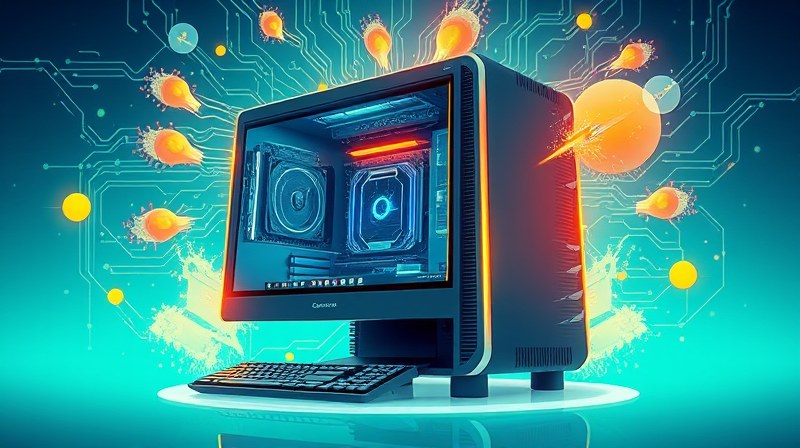Old hardware can often seem like a burden as newer, more powerful devices come out every day. However, there is hope for those who aren’t ready to invest in a completely new PC. Affordable upgrades offer an opportunity to breathe new energy into aging machines, allowing you to enjoy smoother performance and extend the life of your trusted equipment.
In today’s fast-moving digital world, it is easy to feel pressured by the rapid pace of technological change. But with a few well-planned enhancements, you can continue earning great value from your existing device while you save money and reduce electronic waste. Whether you are using your computer for work, gaming, or creative tasks, there is always a way to upgrade and optimize without breaking the bank.
Upgrade Your Storage and Memory
One of the most popular and effective ways to improve system performance is to upgrade the storage options. Swapping out an old mechanical hard drive for a solid-state drive (SSD) can lead to dramatic improvements. Modern SSDs, including state-of-the-art PCIe 4.0 and 5.0 NVMe models, provide near-instantaneous boot times and rapid application loading. Even installing a modest SATA SSD can significantly reduce lag and streamline tasks.
This process is not only cost-effective but also relatively easy to implement for most users. Consider making the following upgrades:
- SSD Upgrade: Replacing your HDD with an SSD for fast boot times and rapid file access.
- RAM Increase: Boosting the physical memory enhances your system's ability to multitask and run modern applications smoothly.
It is important to check your motherboard’s compatibility before choosing an SSD or planning a RAM upgrade. Even older systems can typically support a 2.5-inch SATA SSD, making this upgrade achievable for most users.
Enhance Visual and Processing Power
For those who use their computers for more graphic-intensive tasks or modern games, upgrading the graphics card may be the solution. An improved GPU can transform your experience by delivering enhanced visuals and faster rendering speeds. If you decide to explore this avenue, ensure that your system's power supply unit (PSU) and physical space can accommodate the new component.
Upgrading your graphics processor is a step toward future-proofing your system without the expense of a completely new machine. Consider these points when upgrading:
- Graphics Card Upgrade: Improves gaming performance and creative work output.
- Power Supply Check: Ensure that your PSU can handle additional power requirements.
Similarly, upgrading the CPU is another critical enhancement. A modern CPU can dramatically improve multitasking, software efficiency, and overall speed. Even though some motherboards from previous generations support new processors, you should always verify compatibility and consider any additional cooling needs before making the jump.
Smart Decisions on Budget and Value
For many users, affordability is key. Instead of spending a fortune on a new computer, thoughtfully considered upgrades can bring performance improvements at a fraction of the cost. Refurbished or used business hardware is one avenue that can be explored. Originally designed for durability and efficiency in corporate settings, these systems are well-maintained and built to last. Investing in quality refurbished devices or components can offer excellent value and room for future upgrades.
Don't underestimate the importance of even the smaller components in your system. Upgrading the power supply and adding an uninterruptible power supply (UPS) can help protect your hardware against power surges and outages. This not only supports peak performance but also safeguards your investment in upgraded components.
Step-by-Step Approach for a Successful Upgrade
Start by evaluating your system’s specific needs. Are you facing slow boot times, memory bottlenecks, or graphic performance issues? Answering these questions will guide your upgrade decisions. Here are some practical steps to streamline your upgrade process:
- Assess the Current System: Identify the key areas where performance lags and which upgrades can deliver the most benefit.
- Plan Incremental Upgrades: Start with the most affordable enhancements such as SSD or RAM upgrades before venturing into CPU or GPU replacements.
- Research Compatibility: Confirm that your existing hardware can support upgraded components, paying close attention to motherboard specifications and power supply wattage.
- Budget Wisely: Consider purchasing refurbished or second-hand components from trusted sources to maximize value.
Implementing this strategy not only minimizes costs but also minimizes the risk of incompatibility issues during upgrades. It allows you to gradually improve your system’s performance while learning more about the inner workings of your computer.
Each step in this process involves a combination of practical adjustments and inspiring potential. When you realize that even well-used hardware can be revitalized to meet modern demands, it opens up a world of possibilities. By making thoughtful, strategic decisions, you’re not just extending the life of your device; you’re also investing in a more sustainable and resource-efficient technology future.
This approach resonates with the broader aim of achieving more with less – a key goal in today’s eco-conscious environment. Every small upgrade contributes to reducing e-waste while ensuring that you continue to enjoy an efficient and up-to-date computing experience.
Remember, the value in upgrading does not solely lie in performance gains. It is also about the satisfaction of revitalizing technology you already own. By engaging in this upgrade journey, you become a proactive problem-solver, capable of adapting to technological evolution while managing your expenses wisely.
Explore the possibilities and take the first step toward transforming your aging hardware into a system that meets today’s standards. With a little research, practical investment, and hands-on upgrades, you can create a computer that works for you, not against you.








